Cargo Noir
Author: Serge Laget
Publisher: Asmodee / Days of Wonder
Year: 2011
review by

| x |
|
|
|
|
|
|
|
|
|
|
|
|
|
|
|
|
|
|
|
|
|
|
|
|
|
|
|
|
|
|
|
|
|
|
|
|
|
|
|
|
|
|
|
|
|
|
|
|
|
|
|
|
|
|
|
|
|
|
|
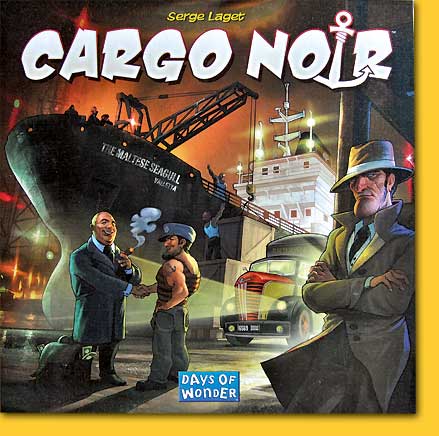 |
Everything you say in the French language has a romantic, mysterious ring to it. Cargo Noir, wow, of course I'm joining! But it already sounds less romantic when it turns out that we are ordinary smugglers... Players cross the seven seas and visit eight different harbours where they load their vessels with all sorts of illegal goods. The profit is invested in villas, yachts, nightclubs and other items to flaunt their prosperity. The richest player wins the game!
|
|
|
|
The players start with three ships each. Every round the ships are placed on one of the available locations, and the associated action is performed in the next round. Ships that sail to the casino of Macao bring their owners two coins from the general supply. Ships on the black market can choose between exchanging a goods marker for one of the markers in the market, or drawing a goods marker from the bag. In Macao all ships are welcome, but in the eight ports the rules of entry are not that simple.
|
|
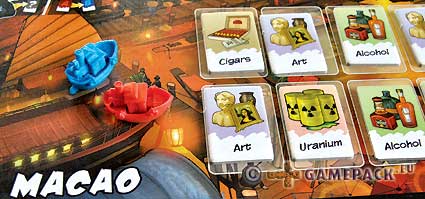 |
|
|
| x |
|
|
|
|
|
|
|
|
|
|
|
|
|
|
|
|
|
|
|
|
|
|
|
|
|
|
|
|
|
|
|
|
|
|
|
|
|
|
|
|
|
|
|
|
|
|
|
|
|
|
|
|
|
|
|
|
|
|
|
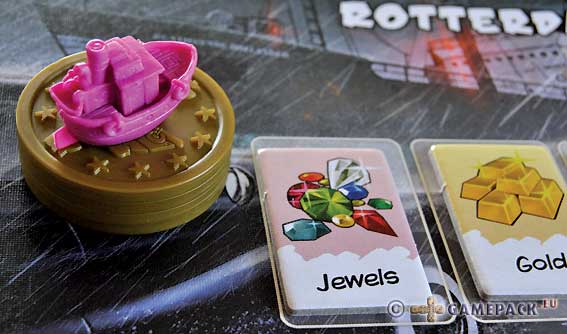 |
|
Each port contains one to three goods markers. If a player wants to claim these markers, he places one of his ships in the port, on top of a stack of coins. Of course the coins come from the player's personal supply! |
|
|
| x |
|
|
|
|
|
|
|
|
|
|
|
|
|
|
|
|
|
|
|
|
|
|
|
|
|
|
|
|
|
|
|
|
|
|
|
|
|
|
|
|
|
|
|
|
|
|
|
|
|
|
|
|
|
|
|
|
|
|
|
| The first player to enter a port is free to choose how many coins he wants to invest, but the next players has to make sure that his stack is higher than that of the players that are already present. If a player finds that in his turn, his ship is the only one there, he may take all the goods markers and place them in his warehouse. If he is not alone, he has two choices: either he increases his bid until he has the highest stack of coins in that specific port, or he takes back his ship and money and gives up. |
|
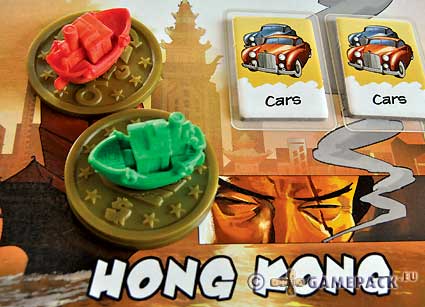 |
|
|
| x |
|
|
|
|
|
|
|
|
|
|
|
|
|
|
|
|
|
|
|
|
|
|
|
|
|
|
|
|
|
|
|
|
|
|
|
|
|
|
|
|
|
|
|
|
|
|
|
|
|
|
|
|
|
|
|
|
|
|
|
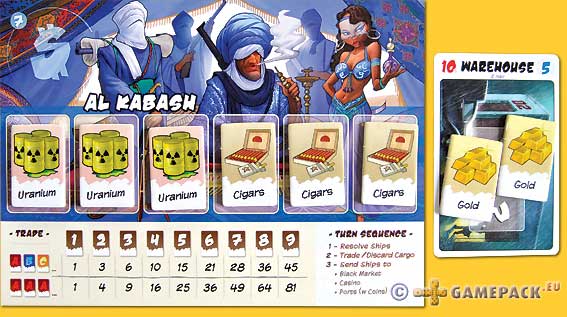 |
|
When the ships' actions have been resolved, a player can use his goods markers to purchase cards (victory points). The warehouse has very limited space for only six markers, any surplus has to be spent or thrown overboard.
|
|
|
| x |
|
|
|
|
|
|
|
|
|
|
|
|
|
|
|
|
|
|
|
|
|
|
|
|
|
|
|
|
|
|
|
|
|
|
|
|
|
|
|
|
|
|
|
|
|
|
|
|
|
|
|
|
|
|
|
|
|
|
|
|
To determine the value of the goods markers, a table is used. For example, three identical markers have a worth of 9, while three different markers are good for 6 points. Most of the cards only score points at the end of the game, but some of them give an additional advantage, such as a mini-warehouse for two goods markers, or an additional ship from the supply.
|
|
 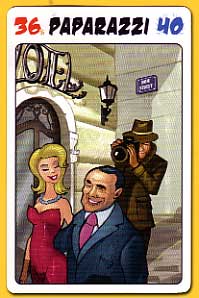  |
| x |
|
|
|
|
|
|
|
|
|
|
|
|
|
|
|
|
|
|
|
|
|
|
|
|
|
|
|
|
|
|
|
|
|
|
|
|
|
|
|
|
|
|
|
|
|
|
|
|
|
|
|
|
|
|
|
|
|
|
|
|
Finally, the player places all his unused ships on the board in Macao or one of the eight ports. The corresponding actions will be resolved in his next turn. After 10 or 11 rounds players count the victory points on their cards, and the player with the highest total wins.
|
|
|
| x |
|
|
|
|
|
|
|
|
|
|
|
|
|
|
|
|
|
|
|
|
|
|
|
|
|
|
|
|
|
|
|
|
|
|
|
|
|
|
|
|
|
|
|
|
|
|
|
|
|
|
|
|
|
|
|
|
|
|
|
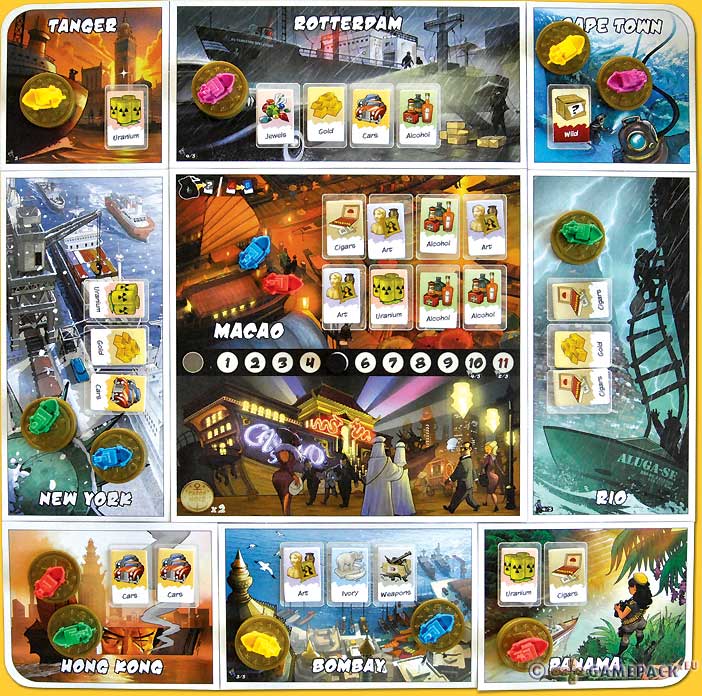 |
| x |
| x |
| x |
 |
|
|
|
|
|
|
|
|
|
|
|
|
|
|
|
|
|
|
|
|
|
|
|
|
|
|
|
|
|
|
|
|
|
|
|
|
|
|
|
|
|
|
|
|
|
|
|
|
|
|
|
Beneath the transparently thin theme, Cargo Noir is an auction game. In the eight ports, eight auctions take place simultaneously. The disadvantage is that the players have to divide their attention over all locations, none of the auctions receive full attention, and it never becomes really exciting. Everybody has only three ships, so the number of auctions where players can participate is limited. Therefore it occurs that a player gets away with a large number of goods markers for a very low price, but it also happens that two players bid sky high because they refuse to give up. The latter makes sense, since you have only three chances per round to do something useful with your ships. If you spend a number of turns on increasing your bid, and still have to go home without goods markers, these turns have been completely wasted. They could better have been spent on a trip to the casino or the black market!
|
|
|
| x |
|
|
|
|
|
|
|
|
|
|
|
|
|
|
|
|
|
|
|
|
|
|
|
|
|
|
|
|
|
|
|
|
|
|
|
|
|
|
|
|
|
|
|
|
|
|
|
|
|
|
|
|
|
|
|
|
|
|
|
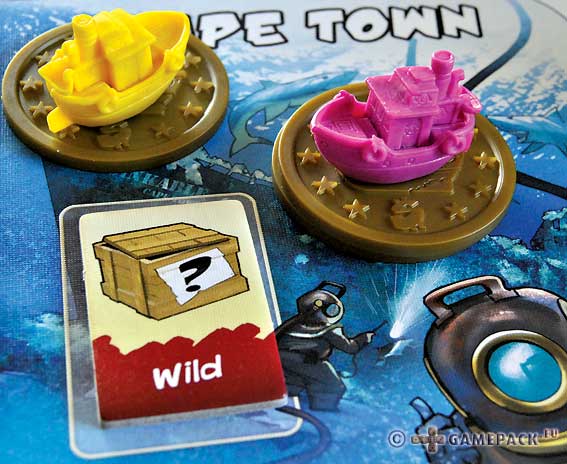 |
|
Because you have to spend many turns on taking money and increasing bids, you can not even collect that many goods markers in 10 rounds. And because space in the warehouse is also limited, it's not an option to save the markers for a really good card.
|
|
|
| x |
|
|
|
|
|
|
|
|
|
|
|
|
|
|
|
|
|
|
|
|
|
|
|
|
|
|
|
|
|
|
|
|
|
|
|
|
|
|
|
|
|
|
|
|
|
|
|
|
|
|
|
|
|
|
|
|
|
|
|
| What it comes down to is that we are scrimping and saving rather than smuggling. Usually the winner is the player that was lucky enough to win a bidding for exactly the right combination of goods markers and could immediately use them to buy a valuable card. |
|
      |
|
|
| x |
|
|
|
|
|
|
|
|
|
|
|
|
|
|
|
|
|
|
|
|
|
|
|
|
|
|
|
|
|
|
|
|
|
|
|
|
|
|
|
|
|
|
|
|
|
|
|
|
|
|
|
|
|
|
|
|
|
|
|
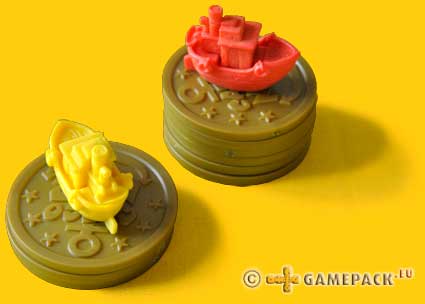 |
A big disadvantage is that as opposed to many other auction games, doing well in the auctions brings you victory points, but not new money. It would have been better if the goods markers could have been sold for money, and the players are free to choose if they invest that money in entering more auctions, or buying victory points. So in addition to the number of ships, the number of rounds and the positions in the warehouse, money is also scarce throughout the game, no matter how well you do in the auctions.
|
|
|
|
Because of all these restrictions, players don't get the opportunity to play strategically, and what remains is a rather random game.
© 2011 Barbara van Vugt
Cargo Noir, Serge Laget, Days of Wonder, 2011 - 2 to 5 players, 8 years and up, 30-90 minutes
|
  |
|
|
|
|
|
|
|
|
|
|
|
|
|
|
|
|
|
|
|
|
|
|
|
|
|
|
|
|
|
|
|
|
|
|
|
|
|
|
|
|
|
|
|
|
|
|
|
|
|
|
  |
|
|
|
|
|
|
|
|
|
|
|
|
|
|
|
|
|
|
|
|
|
|
|
|
|
|
|
|
|
|
|
|
|
|
|
|
|
|
|
|
|
|
|
|
|
|
|
|
|
|
  |
Under an excessive layer of chrome lies a superfluous game |
  |
Nicely executed game, but the game itself is a bit lean |
  |
|
|
|
|
|
|
|
|
|
|
|
|
|
|
|
|
|
|
|
|
|
|
|
|
|
|
|
|
|
|
|
|
|
|
|
|
|
|
|
|
|
|
|
|
|
|
|
|
|
|
| x |
|
|
|
|
|
|
|
|
|
|
|
|
|
|
|
|
|
|
|
|
|
|
|
|
|
|
|
|
|
|
|
|
|
|
|
|
|
|
|
|
|
|
|
|
|
|
|
|
|
|
|
|
|
|
|
|
|
|
|
| x |
|
|
|
|
|
|
|
|
|
|
|
|
|
|
|
|
|
|
|
|
|
|
|
|
|
|
|
|
|
|
|
|
|
|
|
|
|
|
|
|
|
|
|
|
|
|
|
|
|
|
|
|
|
|
|
|
|
|
|
 |
|
|
|
|
|
|
|
|
|
|
|
|
|
|
|
|
|
|
|
|
|
|
|
|
|
|
|
|
|
|
|
|
|
|
|
|
|
|
|
|
|
|
|
|
|
|
|
|
|
|
 |
|
|
|
|
|
|
|
|
|
|
|
|
|
|
|
|
|
|
|
|
|
|
|
|
|
|
|
|
|
|
|
|
|
|
|
|
|
|
|
|
|
|
|
|
|
|
|
|
|
|
| x |
|
|
|
|
|
|
|
|
|
|
|
|
|
|
|
|
|
|
|
|
|
|
|
|
|
|
|
|
|
|
|
|
|
|
|
|
|
|
|
|
|
|
|
|
|
|
|
|
|
|
|
|
|
|
|
|
|
|
|
 |
|
|
|
|
|
|
|
|
|
|
|
|
|
|
|
|
|
|
|
|
|
|
|
|
|
|
|
|
|
|
|
|
|
|
|
|
|
|
|
|
 |
|
|
|
|
|
|
|
|
|
|
|
|
|
|
|
|
|
|
|
|
|
|
|
|
|
|
|
|
|
|
|
|
|
|
|
|
|
|
|
|